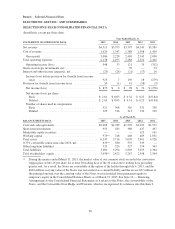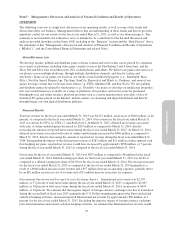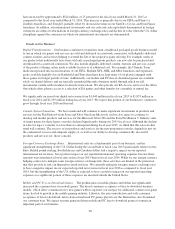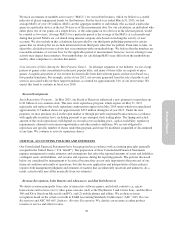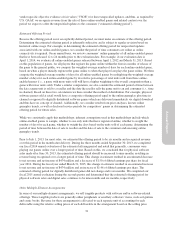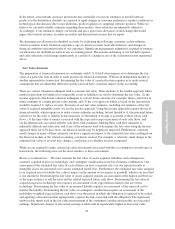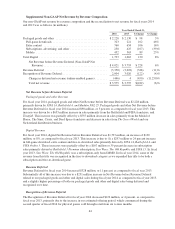Electronic Arts 2015 Annual Report Download - page 104
Download and view the complete annual report
Please find page 104 of the 2015 Electronic Arts annual report below. You can navigate through the pages in the report by either clicking on the pages listed below, or by using the keyword search tool below to find specific information within the annual report.measurement. This fair value assessment is also required in periods subsequent to a business combination. Such
estimates are inherently difficult and subjective and can have a material impact on our Consolidated Financial
Statements.
Assessment of Impairment of Goodwill, Intangibles, and Other Long-Lived Assets. Current accounting
standards require that we assess the recoverability of our finite lived acquisition-related intangible assets and
other long-lived assets whenever events or changes in circumstances indicate the remaining value of the assets
recorded on our Consolidated Balance Sheets is potentially impaired. In order to determine if a potential
impairment has occurred, management must make various assumptions about the estimated fair value of the asset
by evaluating future business prospects and estimated future cash flows. For some assets, our estimated fair value
is dependent upon predicting which of our products will be successful. This success is dependent upon several
factors, such as which operating platforms will be successful in the marketplace. Also, our revenue and earnings
are dependent on our ability to meet our product release schedules. Judgments and assumptions about future cash
flows and remaining useful lives are complex and often subjective. They can be affected by a variety of factors,
including but not limited to, significant negative industry or economic trends, significant changes in the manner
of our use of the assets or the strategy of our overall business and significant under-performance relative to
projected future operating results. When we consider such assets to be impaired, the amount of impairment we
recognize is measured by the amount by which the carrying amount of the asset exceeds its fair value.
In assessing impairment on our goodwill, we first analyze qualitative factors to determine whether it is more
likely than not that the fair value of a reporting unit is less than its carrying amount as a basis for determining
whether it is necessary to perform the two-step goodwill impairment test. The qualitative factors we assess
include long-term prospects of our performance, share price trends and market capitalization, and Company
specific events. If we conclude it is more likely than not that the fair value of a reporting unit exceeds its carrying
amount, we do not need to perform the two-step impairment test. If based on that assessment, we believe it is
more likely than not that the fair value of the reporting unit is less than its carrying value, a two-step goodwill
impairment test will be performed. The first step measures for impairment by applying fair value-based tests at
the reporting unit level. The second step (if necessary) measures the amount of impairment by applying fair
value-based tests to the individual assets and liabilities within each reporting unit. Reporting units are determined
by the components of operating segments that constitute a business for which (1) discrete financial information is
available, (2) segment management regularly reviews the operating results of that component, and (3) whether
the component has dissimilar economic characteristics to other components.
As of our last annual assessment of goodwill in the fourth quarter of fiscal year 2015, we determined that it was
more likely than not that the fair value of our reporting unit exceeded its carrying amount and, as such, we did
not need to perform the two-step impairment test. We have not identified any indicators of impairment since that
assessment.
Our business consists of developing, marketing and distributing video game software content and services using
both established and emerging intellectual properties and our forecasts for emerging intellectual properties are
based upon internal estimates and external sources rather than historical information and have an inherently
higher risk of inaccuracy. If future forecasts are revised, they may indicate or require future impairment charges.
We base our fair value estimates on assumptions we believe to be reasonable, but that are unpredictable and
inherently uncertain. Actual future results may differ from those estimates.
Royalties and Licenses
Our royalty expenses consist of payments to (1) content licensors, (2) independent software developers, and
(3) co-publishing and distribution affiliates. License royalties consist of payments made to celebrities,
professional sports organizations, movie studios and other organizations for our use of their trademarks,
copyrights, personal publicity rights, content and/or other intellectual property. Royalty payments to independent
software developers are payments for the development of intellectual property related to our games. Co-
publishing and distribution royalties are payments made to third parties for the delivery of products.
34




